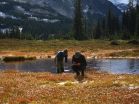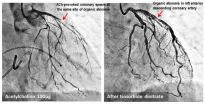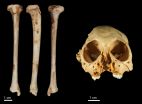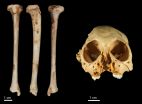(Press-News.org) An international team of scientists has developed what may be the first one-step process for making seamless carbon-based nanomaterials that possess superior thermal, electrical and mechanical properties in three dimensions.
The research holds potential for increased energy storage in high efficiency batteries and supercapacitors, increasing the efficiency of energy conversion in solar cells, for lightweight thermal coatings and more. The study is published today (Sept. 4) in the online journal Science Advances.
In early testing, a three-dimensional (3D) fiber-like supercapacitor made with the uninterrupted fibers of carbon nanotubes and graphene matched or bettered--by a factor of four--the reported record-high capacities for this type of device.
Used as a counter electrode in a dye-sensitized solar cell, the material enabled the cell to convert power with up to 6.8 percent efficiency and more than doubled the performance of an identical cell that instead used an expensive platinum wire counter electrode.
Carbon nanotubes could be highly conductive along the 1D nanotube length and two-dimensional graphene sheets in the 2Dplane. But the materials fall short in a three-dimensional world due to the poor interlayer conductivity, as do two-step processes melding nanotubes and graphene into three dimensions.
"Two-step processes our lab and others developed earlier lack a seamless interface and, therefore, lack the conductance sought," said Liming Dai, the Kent Hale Smith Professor of Macromolecular Science and Engineering at Case Western Reserve University and a leader of the research.
"In our one-step process, the interface is made with carbon-to-carbon bonding so it looks as if it's one single graphene sheet," Dai said. "That makes it an excellent thermal and electrical conductor in all planes."
Dai has worked for nearly four years with Zhong Lin Wang, the Hightower Chair in Materials Science and Engineering, and Yong Ding, a senior research scientist, at Georgia Institute of Technology; and Zhenhai Xia, professor of materials science and engineering, at the University of North Texas; Ajit Roy, principal materials research engineer in the Materials and Manufacturing Directorate, Air Force Research Laboratory, Dayton; and others on a U.S. Department of Defense-Multidisciplinary University Research Initiative (MURI) program (Joycelyn Harrison, Program Manager). Close collaboration was also made with Yuhua Xue, the Research Associate at CWRU and visiting scholar from the Institute of Advanced Materials for Nano-Bio Applications, School of Ophthalmology & Optometry, Wenzhou Medical University, along with Jia Qu and Hao Chen, professors in the Wenzhou Medical University.
To make the 3-D material, the researchers etched radially aligned nanoholes along the length and circumference of a tiny aluminum wire, then used chemical vapor deposition to cover the surface with graphene using no metal catalyst that could remain in the structure.
"Radially-aligned nanotubes grow in the holes. The graphene that sheathes the wire and nanotube arrays are covalently bonded, forming pure carbon-to-carbon nodal junctions that minimize thermal and electrical resistance," Wang said.
The architecture yields a huge surface area, adding to the transport properties, the researchers say. Using the Brunauer, Emmett and Teller theory, they calculate the surface area of this architecture to be nearly 527 square meters per gram of material.
Testing showed the material makes an ideal electrode for highly efficient energy storage. Capacitance by area reached as high as 89.4 millifarads per square centimeter and by length, up to 23.9 millifarads per centimeter in the fiber-like supercapacitor.
The properties can be customized. With the one-step process, the material can be made very long, or into a tube with a wider or narrower diameter, and the density of nanotubes can be varied to produce materials with differing properties for different needs.
The material can be used for charge storage in capacitors and batteries or the large surface could enable storage of hydrogen. "The properties could be used for an even wider variety of applications, including sensitive sensors, wearable electronics, thermal management and multifunctional aerospace systems", Roy said.
The scientists are continuing to explore the properties that can be derived from these single 3D graphene layer fibers and are developing a process for making multilayer fibers.
INFORMATION:
The research was funded by a U.S. Department of Defense-Multidisciplinary University Research Initiative grant under the Air Force Office of Scientific Research, and Wenzhou Medical University.
Washington, DC - September 4, 2015 - Decontamination protocols eradicated both methicillin-resistant Staphylococcus aureus (MRSA) and antibiotic resistant, pathogenic intestinal bacteria, the Enterobacteriaceae, from a pig farm. The research appears online September 4th in ASM's journal Applied and Environmental Microbiology.
The study involved a farm on which both pathogens had been discovered through routine monitoring. The farmer had approached the investigators for help. The Enterobacteriaceae were expressing resistance genes called extended-spectrum β-lactamases ...
WINSTON-SALEM, N.C. - Sept. 4, 2015 - A commonly prescribed antidepressant may alter brain structures in depressed and non-depressed individuals in very different ways, according to new research at Wake Forest Baptist Medical Center.
The study - conducted in nonhuman primates with brain structures and functions similar to those of humans - found that the antidepressant sertraline, a selective serotonin reuptake inhibitor (SSRI) marketed as Zoloft, significantly increased the volume of one brain region in depressed subjects but decreased the volume of two brain areas in ...
Far above the wildfires raging in Washington's forests, a less noticeable consequence of this dry year is taking place in mountain ponds. The minimal snowpack and long summer drought that have left the Pacific Northwest lowlands parched also affect the region's amphibians due to loss of mountain pond habitat.
According to a new paper published Sept. 2 in the open-access journal PLOS ONE, this summer's severe conditions may be the new normal within just a few decades.
"This year is an analog for the 2070s in terms of the conditions of the ponds in response to climate," ...
The misery of motion sickness could be ended within five to ten years thanks to a new treatment being developed by scientists.
The cause of motion sickness is still a mystery but a popular theory among scientists says it is to do with confusing messages received by our brains from both our ears and eyes, when we are moving.
It is a very common complaint and has the potential to affect all of us, meaning we get a bit queasy on boats or rollercoasters. However, around three in ten people experience hard-to-bear motion sickness symptoms, such as dizziness, severe nausea, ...
This news release is available in Japanese.
Researchers at Kumamoto University in Japan have found that patients with coronary spasm have a higher risk of experiencing future heart attack particularly when a spasm occurs at the site of atherosclerotic coronary artery narrowing, i.e., coronary atherosclerotic stenosis.
Angina is caused by the narrowing of the blood vessels that carry blood to the heart, and vasospastic angina patients account for about 40% of all angina patients. The incidence and progression of the disease can be reduced through appropriate drug treatment ...
ALLENDALE, Mich. -- An international team of scientists, including a Grand Valley State University professor and alumni, recently discovered a species of monkey fossil the team has dated to be more than one million years old.
The discovery was made after the team recovered a fossil tibia (shin bone) belonging to the species of extinct monkey Antillothrix bernensis from an underwater cave in Altagracia Province, Dominican Republic. The species was roughly the size of a small cat, dwelled in trees, and lived largely on a diet of fruits and leaves.
"We know that there ...
As climate change accelerates ice melt in the Arctic, polar bears may find caribou and snow geese replacing seals as an important food source, shows a recent study published in the journal PLOS ONE. The research, by Linda Gormezano and Robert Rockwell at the American Museum of Natural History, is based on new computations incorporating caloric energy from terrestrial food sources and indicates that the bears' extended stays on land may not be as grim as previously suggested.
"Polar bears are opportunists and have been documented consuming various types and combinations ...
Natural wonders like tumbling waterfalls, jutting rock faces and banks of wildflowers have long drawn visitors to America's national parks and inspired efforts to protect their beauty.
According to a study published Sept. 4 in Park Science, visitors also value and seek to protect a different kind of threatened natural resource in the parks: dark nighttime skies.
Almost 90 percent of visitors to Maine's Acadia National Park interviewed for the study agreed or strongly agreed with the statements, "Viewing the night sky is important to me" and "The National Park Service ...
(Boston)--Patients with spinal stenosis (SS) experienced good short term benefit, lasting from weeks to months, after receiving epidural steroid injections (ESI).
These findings, which appear in a letter in the journal Pain Medicine, contradict a previously published New England Journal Medicine (NEJM) study that found epidural steroid injections were not helpful in spinal stenosis cases.
It has been one year since the publication of "A Randomized Trial of Epidural Glucocorticoid Steroid Injections for Spinal Stenosis." This was a large scale clinical trial evaluating ...
An international team of scientists have dated a species of fossil monkey found across the Caribbean to just over 1 million years old.
The discovery was made after the researchers recovered a fossil tibia (shin bone) belonging to the species of extinct monkey Antillothrix bernensis from an underwater cave in Altagracia Province, Dominican Republic. The fossil was embedded in a limestone rock that was dated using the Uranium-series technique.
In a paper published this week in the well renowned international journal, the Journal of Human Evolution, the team use three-dimensional ...






